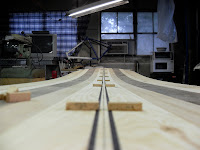 My pop checking out one of the cracks in the deck. He helped me in a time of crisis! We were clamping her up and SNAP! Three times! I almost freaked, but calm and cool Cork kept me sain and glamped up the splits for me.
My pop checking out one of the cracks in the deck. He helped me in a time of crisis! We were clamping her up and SNAP! Three times! I almost freaked, but calm and cool Cork kept me sain and glamped up the splits for me.I didn't document the whole process with the camera, but I will try and write what we did.
First on the bottom side of the deck I drew the centerline for the keel and where the frames would be. I would put any extra 5200 caulk on these lines. It took the keel and 3 frames fore and aft until it ran out.
Then the frames on the board itself were caulked with 5200, extra on deck, and the rails got painted with Titebond III and a 1 inch chip brush (project in total took over 32 0z. titebond). The deck was alingned with centerline and the fore and aft markings I had made and placed gently on top of the frames.
 Then the invaluable Courtland Null and I ran battens across at each station and clamped them down on either side starting in the middle and working aft. Then we worked forward. I'm wondering if a different sequence would have been better to avoid the deck splitting at the nose. Not sure.
Then the invaluable Courtland Null and I ran battens across at each station and clamped them down on either side starting in the middle and working aft. Then we worked forward. I'm wondering if a different sequence would have been better to avoid the deck splitting at the nose. Not sure. We also had to put wedges in some of the battens to get the deck tight to the glue. It was weird this go around. This may have been a result of my initial thickness planing and hand planing a small concave in the bottom of the deck. The splitting as well. I just hope that the deck isn't too lumpy as it's pretty thin to start with.
 The worst split in the nose. This one will be noticeable. The others are far enough out on the rails where they will be sanded off. I couldn't tighten this split up either because of all the bends the wood is taking. I pushed it as it was. The eastern white cedar is definately softer than its western counterpart and is fine in the center but at the rails, it's no good. The grain is too wide. Also I paired it up with the Walnut which is super tough and something to think about in the future.
The worst split in the nose. This one will be noticeable. The others are far enough out on the rails where they will be sanded off. I couldn't tighten this split up either because of all the bends the wood is taking. I pushed it as it was. The eastern white cedar is definately softer than its western counterpart and is fine in the center but at the rails, it's no good. The grain is too wide. Also I paired it up with the Walnut which is super tough and something to think about in the future. Note making in my boat notes book. Later reference is always good. Joe Gass took this pic just as he was on his way out to Hawaii. I hope he sells my boards to the locals. LOL LMAO
Note making in my boat notes book. Later reference is always good. Joe Gass took this pic just as he was on his way out to Hawaii. I hope he sells my boards to the locals. LOL LMAO
"the Wormhole" all clamped up.

































